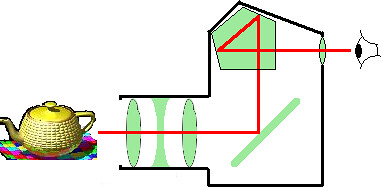Difference between revisions of "Pentaprism"
m |
m (fixed poor formatting in large windows) |
||
| Line 4: | Line 4: | ||
|image= http://farm3.static.flickr.com/2054/2345422972_9748f565fc.jpg | |image= http://farm3.static.flickr.com/2054/2345422972_9748f565fc.jpg | ||
|image_align= right | |image_align= right | ||
| − | |image_text= Light from the subject goes through the lens, is reflected from the mirror, then is flipped through the pentaprism, through the eyepiece lens to the eye. | + | |image_text= Light from the subject goes through the lens,<br>is reflected from the mirror, then is flipped<br>through the pentaprism, through the eyepiece lens to the eye. |
}} | }} | ||
| + | |||
=== Links === | === Links === | ||
* [http://www.ted.photographer.org.uk/camera_types.htm Viewfinder Types] on [http://www.ted.photographer.org.uk/ Ted's Photographics] by Ted Ellis | * [http://www.ted.photographer.org.uk/camera_types.htm Viewfinder Types] on [http://www.ted.photographer.org.uk/ Ted's Photographics] by Ted Ellis | ||
Revision as of 14:43, 27 March 2008
A Pentaprism is a five-sided optical glass element that reflects light through 90°. A variant, the roof pentaprism, has two sloping sides on one of the reflecting surfaces, usually the top, to allow light from the mirror of an SLR to be reflected into an eye-level (reflex) viewfinder with the picture appearing the correct way around to the photographer. This avoids the problem suffered by other reflex viewfinder systems, which can have the image laterally (left-right) reversed - or even upside-down. This made framing difficult, and following a moving subject confusing. The roof pentaprism is the reason for most SLR cameras having a triangular top to their viewfinders.

|
| Light from the subject goes through the lens, is reflected from the mirror, then is flipped through the pentaprism, through the eyepiece lens to the eye. |
Links
- Viewfinder Types on Ted's Photographics by Ted Ellis
- Wikipedia Pentaprism article